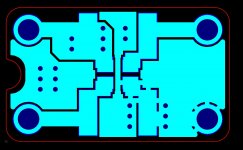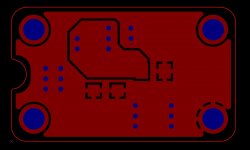It seems like some may be better off convincing TPA to ship the BIII with the CCHD950 not mounted at all.
Good idea, I will send the request to TPA now and will report what's their response
There are 2 U.FL MCLK output sockets on the Dual XO Clock Board, so I don't think you have any problem feed them into two dacs.
^this I understand
can you clarify this please mate? my poor brain is protesting this morning.You don't need feed the MCLK to S/PDIF Interface Board if you don't use the DIT function, or you may connect it directly to the U.FL socket on the FIFO board. However, your have to make the I2S cable with branch by yourself.
or are you simply saying the same as I was in different words? that if you dont need the spdif input,m you dont need to feed the mclk back to the spdif board, or you can duplicate the u.fl with hack? it would be handy I think to have another u.fl on the clock board for times like this, can just be a duplicate without a driver on one, driving 2 dacs is not such a trouble as 16 (even if driving 2 x 9018 is in reality driving exactly 16 parallel dacs)
Last edited:
FYI
Interesting startup in the oscillator market Accusilicon, we make ultra-low phase noise XO/VCXO/TCXO ICs
their XO clocks product reported as
12KHz-20MHz RMS jitter: <50fs (122.88MHz)
Anyone tried these? and with which crystals?
Anyone tried these? and with which crystals?
This is the oscillator module having the lowest 'close-in to the carrier' phase noise I've yet come across.
http://www.oscilloquartz.com/file/pdf/8789.pdf
Last edited:
and its only available at 5 or 10MHz, I can see the $$$$ now for ordering a clock like that at nearly 10x their nominal model. even at these low speeds it uses 8W of power at start up and settles to 2.5W at +12v. none of these clocks or high end crystal references ive seen come in fundemental frequencies that are useful for audio. I dont like the idea of blowing so much coin and still having to generate the clock rather than simply multiply it
^this I understand
can you clarify this please mate? my poor brain is protesting this morning.
or are you simply saying the same as I was in different words? that if you dont need the spdif input,m you dont need to feed the mclk back to the spdif board, or you can duplicate the u.fl with hack? it would be handy I think to have another u.fl on the clock board for times like this, can just be a duplicate without a driver on one, driving 2 dacs is not such a trouble as 16 (even if driving 2 x 9018 is in reality driving exactly 16 parallel dacs)
Sorry, just let me make it more clear. The DIT and DIR ont the s/pdif board are independent from each other. If you don't need the S/PDIF output function then you can leave DIT stop by not feeding it with clock, while the DIR is working and generating I2S. In this case, both of the U.FL sockets on the dual xo clock board are available for the DACs. However, if you still need the s/pdif output function, than you can let it share the MCLK with FIFO board by connecting the U.FL cable from the socket on the FIFO board to the s/pdif board, the two U.FL sockets on the clock boare are still available.
Nice weekend
Re-designed XO adapter PCB compatible with many SMT XO
The old adapter PCBs were run out. I designed a new one, which could compatible with most popular SMT XOs, CCHD957,CCHD950, 7*5, 5*3.2,3.2*2.5,2.5*2(NZ2520S).... Each KIT of GB II will still come with one for free, as well as those who didn't get from GB I.
The old adapter PCBs were run out. I designed a new one, which could compatible with most popular SMT XOs, CCHD957,CCHD950, 7*5, 5*3.2,3.2*2.5,2.5*2(NZ2520S).... Each KIT of GB II will still come with one for free, as well as those who didn't get from GB I.
Attachments
This is the oscillator module having the lowest 'close-in to the carrier' phase noise I've yet come across.
http://www.oscilloquartz.com/file/pdf/8789.pdf
You can find tcxo with great specs in Vectron catalogue:
http://www.vectron.com/products/tcxo/VT-803.pdf
(note that higher freq have usually worse noise so 91dB @10hz for a 26Mhz xo is truly excellent)
Sorry, just let me make it more clear. The DIT and DIR ont the s/pdif board are independent from each other. If you don't need the S/PDIF output function then you can leave DIT stop by not feeding it with clock, while the DIR is working and generating I2S. In this case, both of the U.FL sockets on the dual xo clock board are available for the DACs. However, if you still need the s/pdif output function, than you can let it share the MCLK with FIFO board by connecting the U.FL cable from the socket on the FIFO board to the s/pdif board, the two U.FL sockets on the clock boare are still available.
Nice weekend
thanks mate! yeah I did a bit more reading on the Ti part, thats pretty neat how the DIT/DIX sections are completely independent of each other. initially I was confused as I thought you must have been talking about spdif input and my brain fog prevented me from seeing that it would never really be needed to have the spdif out be perfectly synchronized with main Mclk for reclocked i2s output.
the usage options are many and varied with this board and it seems you have already thought them all through, with procedure and PCB features already set up for them. really mate, congrats on this project its really quite the wonder
The old adapter PCBs were run out. I designed a new one, which could compatible with most popular SMT XOs, CCHD957,CCHD950, 7*5, 5*3.2,3.2*2.5,2.5*2(NZ2520S).... Each KIT of GB II will still come with one for free, as well as those who didn't get from GB I.
Hi Ian,
Is there any chance I could purchase an extra adapter PCB from you? With dual clock board it would be nice to have both XOs positions populated with these adapters.
Ian: I asked in another email amongst other stuff, how to work out the values for the 2 R or C? used on the underside of the XO adapter board?
yeah the vectron stuff is good, not always available as an import item without special permissions if I remember correctly
Usually I use 3 MLCC, 1u(0805), 100n and 10n(0603). However, If the oscillator comes with internal decoupling capacitors, you can leave them open.
Hi Ian,
Is there any chance I could purchase an extra adapter PCB from you? With dual clock board it would be nice to have both XOs positions populated with these adapters.
Yes, it's possible. I'll produce more PCB and list it for the GB II. I know somebody need more to play with different clocks.
ok fair enough, i'm just not always keen on adding arbitrarily chosen decoupling cap values as a one size fits all thing at these speeds and wondered, if I could borrow some scope time what I should be looking for. I figured they were just decoupling positions, but also wondered if they may have something to do with pull up/down resistors for logic levels with some clocks
I left them out for the crystek, as I figure they would probably do more harm than good given theyve already got well chosen cap values inside
have they got np0 in 0603? not easy to find many values in 0805, not as easy as 1206 anyway. might be a good position for one of those murata CLC networks
I left them out for the crystek, as I figure they would probably do more harm than good given theyve already got well chosen cap values inside
have they got np0 in 0603? not easy to find many values in 0805, not as easy as 1206 anyway. might be a good position for one of those murata CLC networks
yeah the vectron stuff is good, not always available as an import item without special permissions if I remember correctly
I'm gonna get a couple samples...
they are rohs so i dont think any restriction applies to EU.
Hi - I might be bumping this thread just briefly - hope you will allow that 
Any of you considering doing something that goes in the other direction, i.e. a high quality interface making recording to a computer possible (at >=384 kHz or e.g. 256 fs or 512 fs 1 bit)?
I'd be very interested, also if you know/have heard of somebody else doing this.
Greetings,
Jesper
Any of you considering doing something that goes in the other direction, i.e. a high quality interface making recording to a computer possible (at >=384 kHz or e.g. 256 fs or 512 fs 1 bit)?
I'd be very interested, also if you know/have heard of somebody else doing this.
Greetings,
Jesper
Yes, it's possible. I'll produce more PCB and list it for the GB II. I know somebody need more to play with different clocks.
Hi Ian
I need a couple of PCB for my dual clock board, but I can't find any information in the GB.
Hi - I might be bumping this thread just briefly - hope you will allow that
Any of you considering doing something that goes in the other direction, i.e. a high quality interface making recording to a computer possible (at >=384 kHz or e.g. 256 fs or 512 fs 1 bit)?
I'd be very interested, also if you know/have heard of somebody else doing this.
Greetings,
Jesper
make sure you get the analogue input stage right, it'll take some serious design to make the most out of such an ADC. I hear a certain designer in our midst is working on an ESS ADC, a ways off yet, for now you could buy the ES9102 dev board
Hey Ian,
+1 on the recording device.........
Thanks,
Drew.
indeed!
haha trying to type Mac->toslink glass->fifo w spdif->Acko AKD12P->Bal-Bal the wire-> d|HD600|b ~~~~~>Massive attack, Heligoland, Paradise Circus is blowing my mind with what is termed on head-fi, an eargasm
I'm going to sound like gushing audiophool, but I know this album VERY well, i've not heard it like this. the percussive 'snap' is soo taught its like being flicked in the back of the head with a rubber band. the cacouphany of brass, live drums, Horace Andy's vocals and swirling delay in 'Girl I love you' is already mesmerizing, even without being able to 'see' ALL the way down into it!
An externally hosted image should be here but it was not working when we last tested it.
the album has guest appearances from just about everyone whos anyone from that era.
just finished up with United Snakes and i'm kinda left gobsmacked
Bravo Ian (Digital input, clocks and fifo buffer), Dustin Foreman (ESS Dac) Beatrice (acko, Dac Layout, Conversion), Owen (the wire, Headphone amps and IV), Robert del Naja (Keys, Protools and vocals), Neil Davidge (Protools), Horace Andy (vocals), Hope Sandoval, Adrian Utley (Guitars), John Baggott (of Portishead..on Keys), Jerry Fuchs (oh my god the drums!), Damon Reece (Drums), Damon Albarn (Guitar, Bass, Synth Bass) and Co ....too many to name (but I tried)...Bravo!!
Last edited:
- Home
- Source & Line
- Digital Line Level
- Asynchronous I2S FIFO project, an ultimate weapon to fight the jitter

